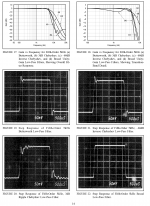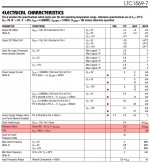Hi folks
I have obtained some Burr-Brown UAF42 Universal Active filter ICs and am thinking of using one to make a LFP to use in the output stage of a DAC.
There is almost no mention online of these chips being used by anyone, so I'm wondering if anyone here has any experience of them?
There is a detailed application document on it's use: www.ti.com/lit/pdf/SBFA002
It looks like a very useful chip and ideal for the application of filtering the analogue output of a DAC, it even has an extra opamp onboard that could be used as a unity gain buffer after the filter.
What frequency should be used for such a LPF - 20kHz or slightly higher, say 24kHz? Which of the filter types supported by this chip would be most suitable? I'm guessing a Butterworth, but I really don't have much knowledge in this areas.
I have obtained some Burr-Brown UAF42 Universal Active filter ICs and am thinking of using one to make a LFP to use in the output stage of a DAC.
There is almost no mention online of these chips being used by anyone, so I'm wondering if anyone here has any experience of them?
There is a detailed application document on it's use: www.ti.com/lit/pdf/SBFA002
It looks like a very useful chip and ideal for the application of filtering the analogue output of a DAC, it even has an extra opamp onboard that could be used as a unity gain buffer after the filter.
What frequency should be used for such a LPF - 20kHz or slightly higher, say 24kHz? Which of the filter types supported by this chip would be most suitable? I'm guessing a Butterworth, but I really don't have much knowledge in this areas.
Attachments
-
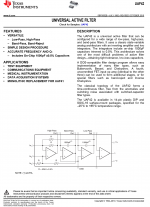 uaf42-1.png216.7 KB · Views: 365
uaf42-1.png216.7 KB · Views: 365 -
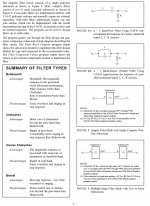 sbfa002-3.png254.2 KB · Views: 182
sbfa002-3.png254.2 KB · Views: 182 -
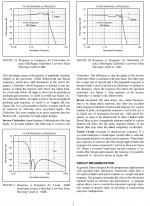 sbfa002-2.png288.1 KB · Views: 161
sbfa002-2.png288.1 KB · Views: 161 -
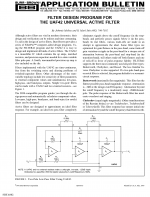 sbfa002-1.png250.9 KB · Views: 204
sbfa002-1.png250.9 KB · Views: 204 -
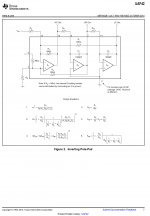 uaf42-7.png115.2 KB · Views: 204
uaf42-7.png115.2 KB · Views: 204 -
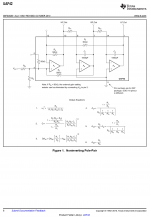 uaf42-6.png120.2 KB · Views: 210
uaf42-6.png120.2 KB · Views: 210 -
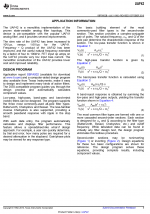 uaf42-5.png228.1 KB · Views: 309
uaf42-5.png228.1 KB · Views: 309 -
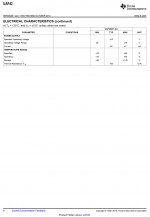 uaf42-4.png66.4 KB · Views: 324
uaf42-4.png66.4 KB · Views: 324 -
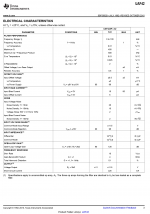 uaf42-3.png141 KB · Views: 318
uaf42-3.png141 KB · Views: 318 -
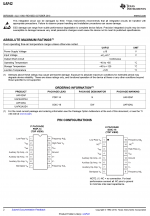 uaf42-2.png172 KB · Views: 343
uaf42-2.png172 KB · Views: 343
Here's the rest of the application document.
Attachments
-
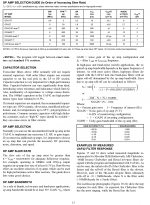 sbfa002-13.png295.5 KB · Views: 77
sbfa002-13.png295.5 KB · Views: 77 -
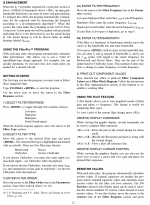 sbfa002-12.png303.7 KB · Views: 70
sbfa002-12.png303.7 KB · Views: 70 -
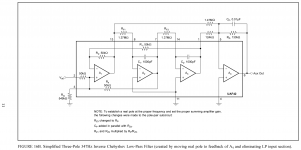 sbfa002-11.png93.5 KB · Views: 91
sbfa002-11.png93.5 KB · Views: 91 -
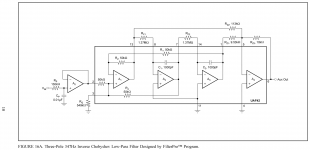 sbfa002-10.png82.9 KB · Views: 87
sbfa002-10.png82.9 KB · Views: 87 -
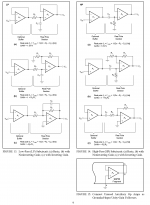 sbfa002-9.png194.8 KB · Views: 85
sbfa002-9.png194.8 KB · Views: 85 -
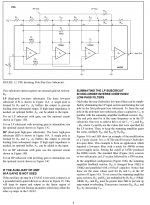 sbfa002-8.png265.4 KB · Views: 128
sbfa002-8.png265.4 KB · Views: 128 -
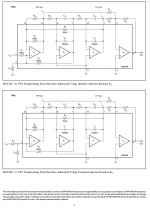 sbfa002-7.png170 KB · Views: 107
sbfa002-7.png170 KB · Views: 107 -
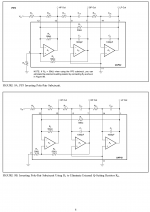 sbfa002-6.png127.4 KB · Views: 88
sbfa002-6.png127.4 KB · Views: 88 -
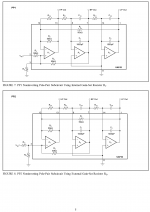 sbfa002-5.png115.6 KB · Views: 104
sbfa002-5.png115.6 KB · Views: 104 -
 sbfa002-4.png383.5 KB · Views: 81
sbfa002-4.png383.5 KB · Views: 81
The TI Filterpro design tool is online, but I have no idea how to design a suitable LPF using it, maybe someone can assist me?
Filter Design Tool
Filter Design Tool
I really don't want to rain on your parade but have you noticed the typical distortion figure of 0.1% at 1kHz for G=1? If its purely low-order then maybe not a biggie but how to tell from the single number?
Hiya Abraxalito.
As you have probably guessed, I didn't notice that, and it would explain why I haven't seen this chip used much.
Seeing as I have the chips, I suppose all there is to do is to try them and see how they sound. If they sound bad, then it's only a small loss and a lesson learned.
I don't know how to design a circuit around them though, it should be pretty simple, but without any examples of the chip being utilised to study, I'm a bit lost.
As you have probably guessed, I didn't notice that, and it would explain why I haven't seen this chip used much.
Seeing as I have the chips, I suppose all there is to do is to try them and see how they sound. If they sound bad, then it's only a small loss and a lesson learned.
I don't know how to design a circuit around them though, it should be pretty simple, but without any examples of the chip being utilised to study, I'm a bit lost.
The caps being 1nF suggest this chip is aimed at the 10kHz to 1MHz frequency range. For audio filtering caps end up being 10nF to 470nF sort of range to achieve reasonable resistor values. To use this for 1kHz would mean resistors up at the 100k to 200k range, and thus suboptimal for noise, and perhaps an issue with bias points and DC offset.
Cheers Mark, so I take it that it would most likely be a waste of time trying to use them in an audio application?
Luckily they were very cheap.
Luckily they were very cheap.
Waste of valuable time. It maybe is a good tip to do research before the actual buying. BTW also counts for TDA1542.
Some older chips were very good and are able to compete with recent technology even decades after their introduction but...most of them were good in their time but are now surpassed by better technology. For post DAC use discrete designs with no global feedback and in some cases transformers are worthwhile experimenting with.
Some older chips were very good and are able to compete with recent technology even decades after their introduction but...most of them were good in their time but are now surpassed by better technology. For post DAC use discrete designs with no global feedback and in some cases transformers are worthwhile experimenting with.
Last edited:
I don't own any TDA1542, nor any other TDA series DACs. I did have a Philips player with a TDA1541 in it but sold it a couple of years ago for what I thought was a quite obscene sum as it didn't sound all that good, I think the chap who made me the obscene offer wanted to remove the PCB and use it to build a DAC.
I did do research before buying the UAF42s, and turned up absolutely nothing beyond a single hackaday page. I studied the datasheet and it made the chip sound ideal for the purpose of building an audio LPF, I just missed the distortion figure.
Transformers are far too expensive to just experiment with, there is no such thing as a cheap but high quality transformer, even secondhand - take a look on eBay how few secondhand audio transformers are available and how much old Sowters pulled out of old equipment cost.
I did do research before buying the UAF42s, and turned up absolutely nothing beyond a single hackaday page. I studied the datasheet and it made the chip sound ideal for the purpose of building an audio LPF, I just missed the distortion figure.
Transformers are far too expensive to just experiment with, there is no such thing as a cheap but high quality transformer, even secondhand - take a look on eBay how few secondhand audio transformers are available and how much old Sowters pulled out of old equipment cost.
Transformers aren't expensive if you make your own using ferrite cores. You'd just need to invest in a winding machine, those aren't too expensive either.
A. if you don't find much on UAF42 that should tell something...
B. There are thankfully more brands than Sowter. I recently sold 2 x Haufe transformers for 40 Euro in total.
Maybe it is a good suggestion to design for highest quality and only go down in that aspect when prices are too high. You will end up somewhere in the middle with good results normally. When one buys only for low prices then final results will correspond to that.
B. There are thankfully more brands than Sowter. I recently sold 2 x Haufe transformers for 40 Euro in total.
Maybe it is a good suggestion to design for highest quality and only go down in that aspect when prices are too high. You will end up somewhere in the middle with good results normally. When one buys only for low prices then final results will correspond to that.
Last edited:
Transformers aren't expensive if you make your own using ferrite cores. You'd just need to invest in a winding machine, those aren't too expensive either.
I have a couple of large ferrite toroids about 60mm diameter, but I know nothing about winding a transformer.
Now that is a challenge as transformers are a lot of technology for such a simple appearing device. Mains transformers are relatively simple but signal transformers are more complicated. You must now the parameters of the ferrite core for a start. I have wound my own in a distant past but prefer ready made ones today. To wind them is 1, to wind real good ones is 2.
Last edited:
I have a couple of large ferrite toroids about 60mm diameter, but I know nothing about winding a transformer.
Winding toroids isn't something I've gotten into so far and probably I won't go there as the machines to do that are a couple of orders of magnitude more expensive than bobbin winding machines. And for not very much advantage in the case of audio signal transformers.
Aah, okay, so forget about using the toroids.
I also have a few Mullard 20mm ferrite cores but don't have the bobbins to go with them.
I also have a few Mullard 20mm ferrite cores but don't have the bobbins to go with them.
If the cutoff frequency is above the audio range, then this chip might well work. It does look very convenient; a second order filter with just a couple of resistors sure is handy. Maybe you could cascade them for higher order filters. But you don't want the filter to intrude on the audio range.
I wouldn't use this for active filters in the audio range, like a crossover. Capacitor distortion really matters here. Who knows what kind of capacitors they have in there, and what kind of linearity and stability they have?
I wouldn't use this for active filters in the audio range, like a crossover. Capacitor distortion really matters here. Who knows what kind of capacitors they have in there, and what kind of linearity and stability they have?
It does look very convenient; a second order filter with just a couple of resistors sure is handy.
Yeah, that was what I thought, I was thinking a Burr-Brown chip as a LPF after a BB DAC might be a nice, elegant solution. I wonder if they made any filter ICs specifically for audio use?
You never know, I might one day have a need to filter something non-audio and these will come in handy.
LT15697 looks interesting, but I'm not sure if the noise and distortion figures are good enough for audio.
LTC1569-X, 10th Order, Linear-Phase Lowpass Filter Family is Tunable with a Single External Resistor | Analog Devices
LTC1569-X, 10th Order, Linear-Phase Lowpass Filter Family is Tunable with a Single External Resistor | Analog Devices
Attachments
Once through a switched-cap filter like that there could be unfortunate beats/artifacts if the signal ever goes to a class-D amplifier.
- Home
- Source & Line
- Analog Line Level
- UAF42 Universal Active Filter
